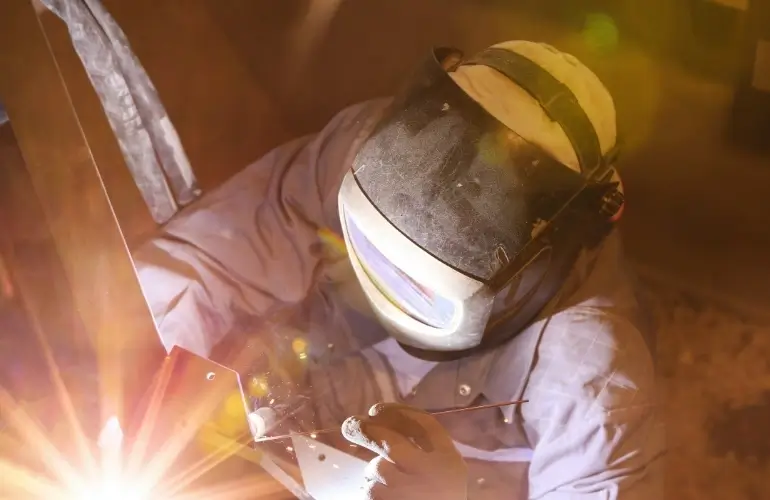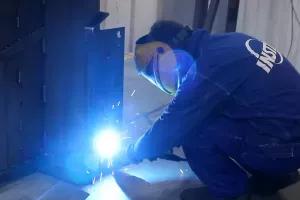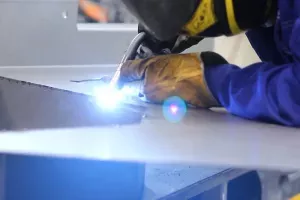Welding
Welding Welding is the most commonly used technology in the industry for joining metals.
Welding involves joining two materials using a filler material or without it; the filler used has identical or similar properties to the welded material. Depending on the type of material and the desired effect, welding can be done using MAG, MIG, MIG/MAG, or TIG methods. We perform professional welding of black steel and stainless steel using MIG/MAG and TIG methods. These are the most commonly used welding methods in the industry, ensuring high quality and durability of the welds and joined elements.

Welding steel structures is a process of joining at least two elements using heat, pressure, or both. It is one of the most important techniques used in the metal industry, enabling the creation of strong and durable connections. Welding is essential in many fields, such as construction, automotive, aviation, and heavy industry. Our company offers professional services performed by experienced specialists. We use modern technologies and equipment, guaranteeing the highest quality and precision of execution.
Diverse Welding Techniques
There are many different welding techniques that can be tailored to the specifics of the task at hand. The most popular include arc welding, TIG (Tungsten Inert Gas), MIG/MAG (Metal Inert Gas/Metal Active Gas), and plasma welding. Each of these methods has its unique advantages and applications. Arc welding is the most versatile and allows for joining various types of metals. TIG is particularly useful for welding non-ferrous metals, such as aluminum or titanium. MIG/MAG is fast and efficient, ideal for welding steel. Plasma welding allows for precise cutting and welding of even the hardest metals.
MIG/MAG Welding
MIG/MAG welding involves using a consumable electrode in an inert or active gas shield. The inert shielding gas, which does not participate in the welding process, is usually argon. The active shielding gas is typically carbon dioxide. In the MIG/MAG method, an electric arc is struck between the welding material and the electrode in the form of a wire. The arc and the pool of molten metal are protected by a stream of inert or active gas. This method is suitable for welding most materials if appropriate electrode wires are chosen for different metals.
Advantages of MIG/MAG welding include:
- good quality welds;
- ability to weld various types of materials;
- low costs;
- capability to weld elements with a wide range of thicknesses;
- ability to weld in all positions.
TIG Method
In the TIG (Tungsten Inert Gas) method, the welding arc is formed between a non-consumable tungsten electrode and the workpiece. The shielding gas is inert and does not affect the welding process. Argon is typically used as the shielding gas, protecting the weld and the electrode from oxidation. In the TIG method, additional filler material is not necessary. Welded elements can be joined by melting the welding groove. If filler material is used, it is manually introduced into the molten pool rather than fed through the welding torch as in the MIG/MAG method.
Advantages of TIG welding include:
- very high quality and cleanliness of welds;
- ability to weld various materials with a wide range of thicknesses (even very thin sheets);
- no spatter;
- ability to weld in all positions.
We perform welding of black steel, stainless steel, and other materials in our facility in Pleszew, Wielkopolska, about 100 km from Poznań.
Machine Park
We perform welding on semi-automatic welding machines from Esab and Kemppi for the MIG/MAG method, and Kemppi and Sherman for the TIG method.
Welding Aluminum and Other Non-Ferrous Metals
Welding non-ferrous metals such as aluminum, copper, titanium, or magnesium differs from welding steel due to the specific properties of these materials. They require an appropriate approach and the use of specialized welding methods to achieve strong and durable joints.
For aluminum, important factors are its low melting point and high thermal conductivity. Therefore, TIG welding is most commonly used for this metal, allowing for precise control of the energy introduced into the material and minimizing the risk of overheating and damage to the elements.
Welding copper, titanium, and magnesium also requires specialized techniques. TIG and MIG welding are commonly used for copper, while TIG welding is recommended for titanium and magnesium due to the high reactivity of these metals with oxygen and other gases.
Welding Steel
Structures Welding steel structures encompasses various applications, including bridges, machinery, and industrial buildings. Due to the weight and size of these structures, the welding process must be precise and durable to ensure adequate strength and safety.
For welding steel structures, MIG/MAG and TIG methods are often used. The choice of method depends on the type of steel, the thickness of the elements, and the quality requirements of the welds. Proper surface preparation, such as removing rust, paint, or grease, also impacts the quality and durability of the welds. Welding steel structures also requires considering factors like welding stress control to prevent deformation or cracking.
Who Our Welding Services Are For
Our welding services are aimed at a wide range of clients. We work with both small companies and large industrial enterprises. We handle orders for the construction, automotive, aviation, energy, and many other industries. Every client is important to us, so we always tailor our services to individual needs and expectations. We ensure that our welding is not only solid and durable but also aesthetically pleasing. We care about our clients' satisfaction, always striving to meet even the most demanding tasks.




